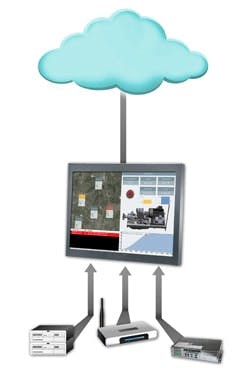Smart field devices and the control systems to which they connect contain a wealth of condition monitoring information that can be used to improve plant operations. It can be challenging, however, to collect, store, and provide access to this data. In many instances, the best approach is to use human machine interface (HMI) software to perform these tasks.
Modern HMIs can be effectively used as a hub for gathering information from smart field devices and controllers and for supplying this data to remote users and condition monitoring systems. With support for hundreds of protocols and the ability to incorporate custom drivers when needed, there’s virtually no smart field device or controller that an HMI can’t connect to via a digital data link.
Hardware devices designed specifically for hosting HMIs, whether wired or wireless, are now using built-in chip sets that employ specific secure connectivity protocols such as OPC-UA. These protocols make the hardware devices safe in a wired or wireless enterprise when collecting data and when runtime components exist as cloud-based services.
Standard Ethernet interfaces and Internet connections can be used for securely distributing this collected data to remote users and condition monitoring systems, and modern HMIs make these communications easy to establish with support for OPC and other data schema standards.
[sidebar id="5"]
HMIs need to connect to two main types of devices to collect the plant operating data used for condition monitoring: controllers and smart field devices. Connections to PLCs, motor controllers, and other similar components are generally made via Ethernet, though older controllers may require serial or other proprietary connections (see Figure 1).
Whether the HMI is hosted on a PC or an embedded platform such as Windows Embedded or Linux, it will most likely have an Ethernet port that can connect to many controllers and support multiple protocols through this single connection. Popular Ethernet protocols that modern HMIs support include EtherNet/IP, Modbus TCP, and Profinet.
For serial connections, RS-232 and RS-422/485 connections are common; hundreds of protocols are in use. Many modern HMIs will support more than 200 protocols. For unsupported protocols, end users can write custom drivers.
Smart field devices can be smart instruments, pneumatic valve manifolds, or other types of devices. A device is defined as smart if it supports a digital communications protocol. Common smart field-device communication protocols include DeviceNet, Foundation Fieldbus, and Profibus DP and PA. Modern HMIs will have support for these protocols built in, easing connectivity. Often, the best way to distribute plant data to users is via the cloud, following these steps:
- Choose a cloud service provider
- Select an HMI with built-in cloud support
- Connect the HMI to the cloud
- Establish secure access for remote and local devices.
Modern HMIs easily partner with cloud applications and data storage through native built-in drivers and interfaces to historians and automation systems. This allows for connectivity to cloud-based runtime and historian data servers. Using a cloud service provider frees up an HMI to perform on-the-fly analytics and execute various efficiency-focused applications.
Cloud-based historians can aggregate data from many sources. Users should select an HMI that offers built-in cloud support, as this will greatly ease cloud connectivity. Cloud-based connectivity can take many forms (wired and wireless, for example), but each type of connection requires drivers, which should be included with the HMI.
Choosing an advanced HMI software package and secure hardware that meets all end-user requirements with built-in features can save hundreds of development and IT security configuration hours. It also opens avenues for implementing several types of security. These types of designs provide security-in-depth or layered security as needed to meet enterprise and business requirements.
When plant data is collected and stored in the cloud, any Internet-capable device can securely access it. Mobile HMI devices (smartphones, tablets) can choose from several connection methods. If the device will be used to view and analyze information or send commands, it can be used with a local or cloud-based runtime server. A connection can be made using an HTML5 browser already installed on the HMI.
Choose a software package that offers a wide variety of automation, collection, analysis, and dashboard displays and control interfaces out of the box. Reports and alarm and event management also should be available.
Connections between the HMI and a condition monitoring system are generally made through Ethernet ports, as the platform hosting the HMI and the condition monitoring system will almost always have an Ethernet port and will support connectivity through protocols such as Ethernet IP.
It’s possible to connect controllers and even some smart field devices directly to mobile HMI devices and monitoring systems, but using the HMI is usually a better choice; secure-connectivity support is built in.




